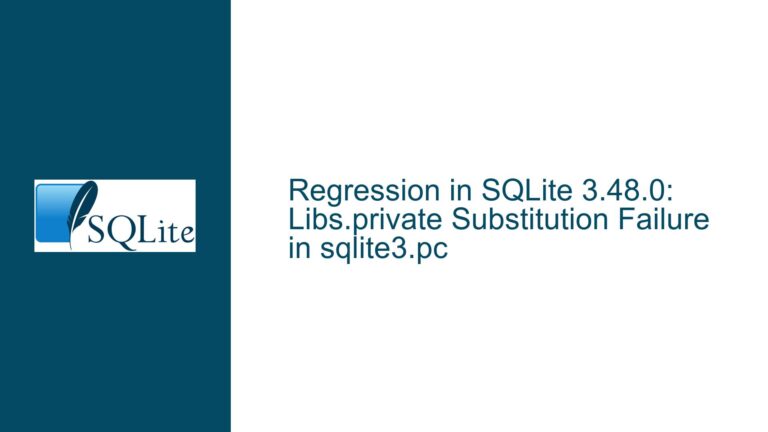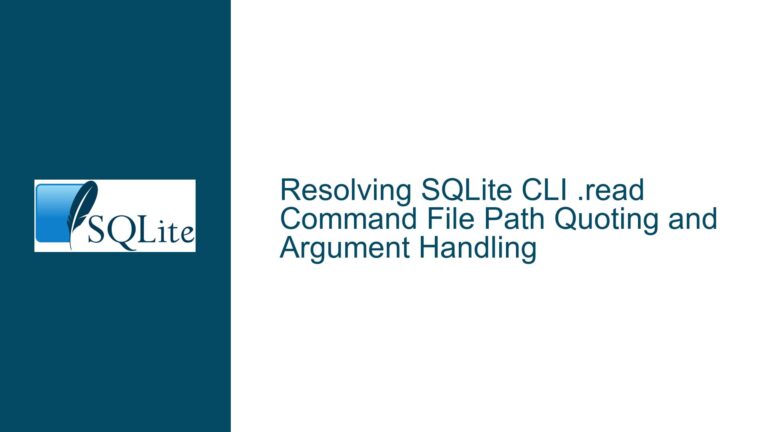Opening SQLite Databases via File Descriptor on Linux: Read-Only Access Challenges and Solutions
Understanding SQLite’s File Descriptor-Based Read-Only Access Requirements
The ability to interact with SQLite databases using file descriptors instead of filenames is a nuanced requirement that arises in specialized scenarios, particularly on Linux systems. This approach becomes critical when handling large databases where copying files is impractical, or when integrating SQLite into systems that expose file descriptors as primary handles. The core challenge lies in SQLite’s default reliance on filenames for database connections and its internal assumptions about file management. While SQLite does not provide a direct API to initialize a database connection from an existing file descriptor, several workarounds exist. These solutions involve leveraging operating system features (such as /dev/fd virtual filesystems) and SQLite’s advanced configuration options (like URI filenames and VFS shims). However, these methods introduce complexities related to file descriptor duplication, advisory locks, and read-only constraints that must be carefully managed to avoid database corruption or unexpected behavior.
Key Technical Constraints
- Immutable Database Requirement: The database must remain unmodified during access
- File Descriptor Lifetime Management: Preventing premature closure of descriptors
- POSIX Advisory Lock Interactions: Avoiding conflicts with SQLite’s locking mechanisms
- VFS Layer Compatibility: Ensuring the virtual file system layer handles descriptor-based access
Common Pitfalls When Accessing Databases Through File Descriptors
Improper URI Formulation for /dev/fd Paths
Developers often construct incorrect URI strings when attempting to access file descriptors through Linux’s virtual filesystem. A malformed URI like file:/dev/fd/3 (missing triple slash) or file://dev/fd/5 (missing root slash) will fail because SQLite requires absolute paths in URI format. The correct syntax file:///dev/fd/N explicitly references the file descriptor number within the root filesystem context.
Missing SQLITE_OPEN_READONLY and SQLITE_OPEN_URI Flags
Omitting either of these flags during connection initialization causes catastrophic failures. The SQLITE_OPEN_READONLY flag enforces immutable access, while SQLITE_OPEN_URI enables parsing of complex URI parameters. Without both flags, SQLite may attempt write operations or misinterpret the descriptor path as a regular filename.
File Descriptor Ownership and Duplication Issues
SQLite internally duplicates provided file descriptors through the /dev/fd interface. However, developers might prematurely close the original descriptor before database initialization completes, leading to race conditions. The operating system maintains reference counts for open descriptors, but timing issues can still occur if descriptor management isn’t synchronized with connection lifecycle events.
WAL Mode and Journal File Handling
Even with read-only access, SQLite checks for write-ahead log (WAL) files and journal modes configured during database creation. If the original database was used with WAL mode (unlikely given the problem constraints), the read-only connection might still attempt to access non-existent WAL files through the file descriptor interface, causing errors.
Advisory Lock Conflicts from Multiple Handles
POSIX advisory locks associated with file descriptors can conflict if other processes (or even threads) access the same database through different interfaces. While the immutable=1 URI parameter theoretically disables locking, improper implementation might still trigger lock checks that fail due to descriptor-based access patterns.
Filesystem Mount Options and Seccomp Restrictions
In hardened Linux environments, filesystems mounted with noexec or nodev flags might block access to /dev/fd virtual paths. Similarly, seccomp filters could prevent the openat system calls that SQLite uses internally when resolving descriptor paths, resulting in silent failures.
Comprehensive Implementation Strategy for Robust Descriptor-Based Access
Step 1: Validate File Descriptor State
Before attempting SQLite operations, confirm the descriptor’s validity and capabilities using fcntl:
int flags = fcntl(fd, F_GETFL);
if (flags == -1) { /* Handle invalid descriptor */ }
if ((flags & O_ACCMODE) != O_RDONLY) { /* Ensure read-only mode */ }
if (lseek(fd, 0, SEEK_SET) == -1) { /* Verify seekability */ }
This checks for descriptor viability, read-only status, and random access capability (critical for SQLite’s page-based access). Non-seekable descriptors (e.g., pipes) cannot host SQLite databases.
Step 2: Construct URI with Precise Parameters
Build the connection URI with strict formatting:
char uri[256];
snprintf(uri, sizeof(uri),
"file:///dev/fd/%d?mode=ro&immutable=1&nolock=1",
fd);
The mode=ro parameter reinforces read-only access at the VFS layer, while immutable=1 tells SQLite to skip all write attempts and lock checks. nolock=1 disables internal locking mechanisms that would otherwise fail with descriptor-based access.
Step 3: Configure Connection Flags and VFS
Initialize the connection with explicit flags:
sqlite3* db;
int rc = sqlite3_open_v2(
uri,
&db,
SQLITE_OPEN_READONLY | SQLITE_OPEN_URI | SQLITE_OPEN_NOFOLLOW,
"unix" // Explicitly use default UNIX VFS
);
The SQLITE_OPEN_NOFOLLOW flag prevents symbolic link attacks through /dev/fd, though in practice this is less critical when using genuine file descriptors. Specifying the "unix" VFS ensures compatibility with descriptor handling routines.
Step 4: Implement Custom VFS Shim for Advanced Scenarios
When default VFS behavior proves inadequate (e.g., custom locking requirements), create a VFS shim:
static int xOpen(sqlite3_vfs* vfs, const char* zName,
sqlite3_file* file, int flags, int* outFlags) {
int fd = extract_fd_from_zName(zName); // Parse /dev/fd/N
return unixOpen(vfs, zName, file, flags, outFlags);
}
sqlite3_vfs* pUnixVfs = sqlite3_vfs_find("unix");
sqlite3_vfs* pFdVfs = sqlite3_malloc(sizeof(*pFdVfs));
memcpy(pFdVfs, pUnixVfs, sizeof(*pFdVfs));
pFdVfs->xOpen = xOpen;
sqlite3_vfs_register(pFdVfs, 0);
This example demonstrates a minimal VFS shim that intercepts open calls while delegating other operations to the standard UNIX VFS. More sophisticated implementations might modify locking behavior or journal handling.
Step 5: Enforce Transaction and Caching Constraints
After connection establishment, execute pragmas to reinforce safety:
PRAGMA query_only = ON;
PRAGMA locking_mode = EXCLUSIVE; // Bypass lock attempts
PRAGMA cache_size = -2000; // KiB-based memory limit
These pragmas add layers of protection against accidental writes and memory bloat. query_only provides a software-enforced read-only barrier at the SQL level, complementing the lower-level URI parameters.
Step 6: Monitor File Descriptor Leaks and Reference Counts
Integrate descriptor lifecycle tracking using wrapper functions:
typedef struct {
sqlite3* db;
int fd_orig;
} FdDbHandle;
FdDbHandle openFdDb(int fd) {
FdDbHandle h;
h.fd_orig = dup(fd); // Preserve original descriptor
// ... SQLite open logic using h.fd_orig ...
return h;
}
void closeFdDb(FdDbHandle h) {
sqlite3_close(h.db);
close(h.fd_orig); // Release after DB closure
}
This pattern prevents descriptor reuse issues by maintaining a dedicated duplicate for SQLite’s use. The explicit dup() call ensures that closing the SQLite connection doesn’t affect other users of the original descriptor.
Step 7: Handle Journal and WAL File Edge Cases
Even in read-only mode, SQLite may check for existing journals. Implement a VFS shim that virtualizes these checks:
static int xAccess(sqlite3_vfs* vfs, const char* zName, int flags, int* pResOut) {
if (strstr(zName, "-wal") || strstr(zName, "-journal")) {
*pResOut = 0; // Report missing WAL/journal files
return SQLITE_OK;
}
return unixAccess(vfs, zName, flags, pResOut);
}
This override prevents SQLite from seeking non-existent WAL files when the main database is opened in descriptor mode, avoiding false corruption warnings.
Step 8: Benchmark and Optimize Page Cache Performance
Descriptor-based access can introduce subtle performance differences compared to regular file access. Profile with:
PRAGMA cache_size = -20000; // 20MB cache
PRAGMA mmap_size = 268435456; // 256MB MMAP
Adjust these values based on the database’s working set size and available memory. MMAP can significantly improve performance for large databases accessed via descriptors by reducing userspace/kernelspace copying.
Step 9: Implement Comprehensive Error Handling
Anticipate and handle descriptor-specific errors:
rc = sqlite3_open_v2(...);
if (rc == SQLITE_CANTOPEN) {
if (errno == EBADF) {
// Invalid file descriptor
} else if (errno == EACCES) {
// Descriptor permissions mismatch
}
} else if (rc == SQLITE_READONLY) {
// Immutable parameter missing
}
Map SQLite error codes to underlying UNIX errors for precise diagnostics. This differentiation is crucial when debugging descriptor permission issues versus general SQLite configuration problems.
Step 10: Cross-Process Synchronization and Fork Safety
If using the descriptor in multi-process environments, enforce pre-fork initialization:
pthread_atfork(NULL, NULL, [](){
// Child process: close all SQLite connections
sqlite3_shutdown();
});
This prevents file descriptor inheritance issues across fork boundaries. SQLite connections should never be shared between processes, even when using the same underlying descriptor.
Advanced Configuration for High-Concurrency Scenarios
When multiple threads access the same database through separate descriptors, implement a descriptor pooling system with reference counting:
typedef struct {
int fd;
sqlite3* db;
pthread_mutex_t lock;
int refcount;
} FdPoolEntry;
FdPoolEntry* pool_get(int fd) {
// Lock global pool mutex
for each entry in pool {
if (entry->fd == fd) {
entry->refcount++;
return entry;
}
}
// Create new entry with dup(fd) and sqlite3_open
}
void pool_release(FdPoolEntry* entry) {
if (--entry->refcount == 0) {
sqlite3_close(entry->db);
close(entry->fd);
}
}
This pattern manages concurrent access while preventing descriptor exhaustion. Each thread gets its own SQLite connection but shares the underlying file descriptor through duplication.
Forensic Analysis of Descriptor-Based Database Corruption
If a database opened via file descriptor shows corruption signs, follow this diagnostic protocol:
- Verify Descriptor Integrity: Use
lseek(fd, 0, SEEK_END)to confirm the descriptor points to a valid file - Check for WAL File Conflicts: Search for
<database>-walfiles in the original directory - Audit Advisory Locks: Use
lslocks -p <pid>to detect conflicting locks - Inspect SQLite’s Internal State:
PRAGMA integrity_check; SELECT * FROM sqlite_master WHERE type='table'; - Trace System Calls: Attach
strace -f -e file,desc sqlite3 test.dbto monitor file operations
Cross-reference these diagnostics with the SQLITE_OPEN_ flags and URI parameters used during initialization. Common corruption vectors include missing immutable=1 parameters leading to attempted writes, or descriptor reuse between read-write and read-only connections.
Performance Optimization Techniques
Leveraging Direct I/O Bypass
For extremely large databases, bypass the OS page cache using direct I/O:
int fd = open("/path/db", O_RDONLY | O_DIRECT);
Combine with SQLite’s PRAGMA mmap_size=0 to prevent double caching. This approach requires 512-byte aligned memory buffers and careful performance testing.
Asynchronous Prefetching
Implement a background thread that reads ahead using posix_fadvise:
posix_fadvise(fd, 0, 0, POSIX_FADV_SEQUENTIAL);
This hints to the kernel that the file will be accessed sequentially, improving read-ahead caching efficiency for full-table scans.
Custom Page Cache Implementation
Override SQLite’s default page cache with a descriptor-aware implementation:
sqlite3_config(SQLITE_CONFIG_PAGECACHE, my_pool, MY_PAGE_SIZE, MY_CACHE_PAGES);
This allows fine-grained control over memory usage, particularly important when multiple descriptor-based connections are active simultaneously.
Security Considerations
Descriptor Leak Prevention
Always wrap descriptor-based database connections in capability-aware containers:
#include <sys/capability.h>
// Drop capabilities after open
cap_t caps = cap_get_proc();
cap_clear(caps);
cap_set_proc(caps);
This follows the principle of least privilege, preventing accidental descriptor leakage through SQLite functions.
SELinux/AppArmor Policy Configuration
Create mandatory access control policies that allow /dev/fd access but block regular file writes:
# AppArmor example
/dev/fd/[0-9]* r,
This granular policy permits descriptor access while maintaining overall system security.
Cross-Platform Compatibility Notes
While the /dev/fd technique is Linux-specific, other platforms have analogous mechanisms:
- macOS: Use
/dev/fdsimilarly but watch for differences in maximum descriptor limits - FreeBSD:
/dev/fdexists but requiresO_CLOEXEChandling - Windows: Use
HANDLE-basedAPIs withsqlite3_win32_set_directory
Always test descriptor-based access under realistic load conditions, as platform-specific VFS implementations may exhibit subtle behavioral differences in lock contention and error recovery.






